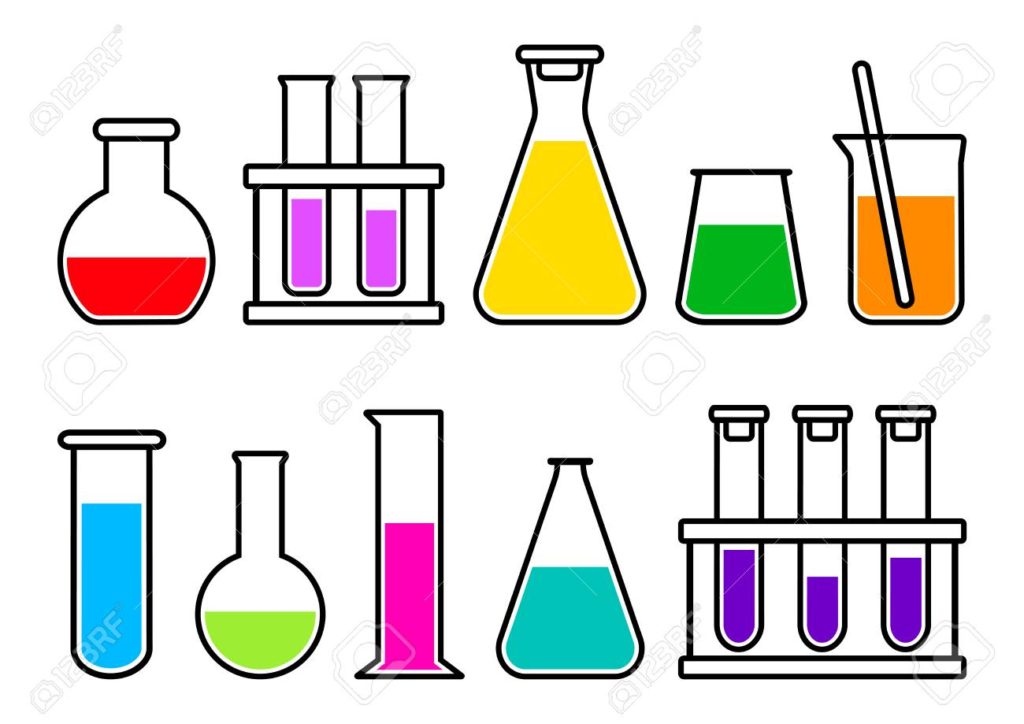Table of Contents
HANDS-ON CHEMISTRY
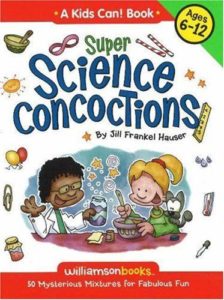 |
Jill Frankel Hauser’s Super Science Concoctions (Williamson, 2007) is a nicely organized collection of “50 Mysterious Mixtures for Fabulous Fun.” Kids begin with “Strange-But-True Brews,” in the course of which they learn about molecules and solutions, then proceed through the phases of matter, chemical reactions, “Go With the Flow,” in which they explore viscosity, density, and immiscibility, and finally “Goo Globs of Fun,” in which they experiment with polymers, colloids, and gels. For ages 6-12. |
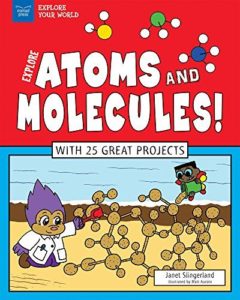 |
Janet Slingerland’s Explore Atoms and Molecules! (Nomad, 2017) is an introduction to atoms, elements, molecules, and chemical reactions, with Words to Know and fact boxes, and 25 hands-on projects, among them building molecular models and creating a Periodic Table guessing game. For ages 7-10. |
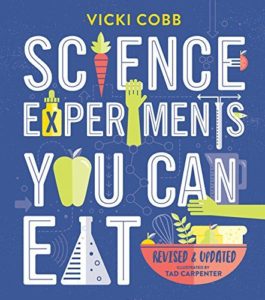 |
Vicki Cobb’s Science Experiments You Can Eat (HarperCollins, 1984) variously covers Solutions (with rock candy and red-cabbage pH indicator); Suspensions, Colloids, and Emulsions (with mayonnaise and strawberry bombe); Carbohydrates and Fats (with syrup, grape jelly, and butter); Proteins (meringues, custard, and biscuits); and much more. It’s all hands-on fun, with reader-friendly explanations. A great pick for ages 7-12. |
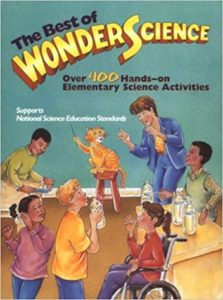 |
The American Chemical Society’s The Best of WonderScience – available for purchase as a book; sample activities on the website – has literally hundreds of chemistry-based activities for ages 7 and up. |
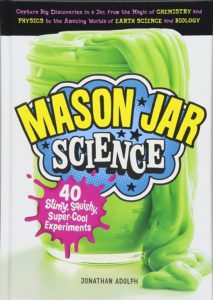 |
Jonathan Adolph’s Mason Jar Science (Storey, 2018) is a collection of 40 cool experiments in the fields of chemistry, earth science, botany, biology, and physics, all with Mason jars. For ages 8-12. |
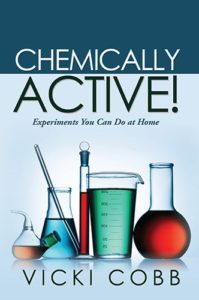 |
Vicki Cobb’s Chemically Active! (Lippincott, 1987) has much better than average experiments, clear instructions, and reader-friendly background information. For example, kids isolate carbon dioxide, “split” water, make iron sulfate and test compounds for iron, electroplate a penny, and make a galvanometer and test solutions for their ability to conduct an electric current. Kids may need some help, depending on their ages. This is – for no conceivable reason – out of print, but is available in inexpensive used editions. Well worth tracking down for chemists ages 9 and up. |
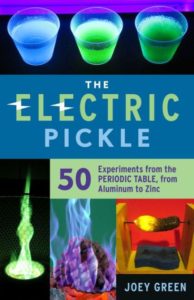 |
Joey Green’s The Electric Pickle (Chicago Review Press, 2017) has 50 irresistible experiments based on the Periodic Table. Make ghastly green eggs, black-light jello, and mystery sand and do a spectacular pH-based color-changing experiment with milk of magnesia. For ages 10 and up, |
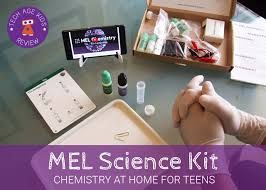 |
MEL Science is a subscription service for ages 9-14, in which a hands-on chemistry kit of reagents, equipment, and an instruction manual arrives each month. There’s an option to expand on the service through an informative smartphone app and website links. |
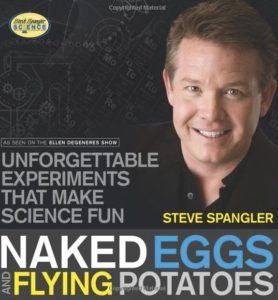 |
Steve Spangler’s Naked Eggs and Flying Potatoes (Greenleaf Books, 2010) – along with the famous mentos geyser experiment – has a section on Kitchen Chemistry. Make Taco Sauce, Penny Cleaner, a Seven-Layer Density Column, and Color Changing Milk. Illustrated with great photos of experimenting kids. For ages 9 and up.Also see Spangler’s Fire Bubbles and Exploding Toothpaste (2011). See the Steve Spangler Science website for experiments and activities, resources, and lab supplies. |
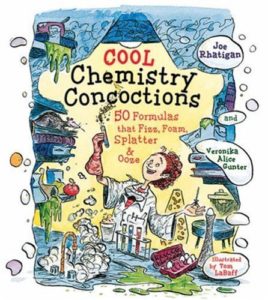 |
Joe Rhatigan’s Cool Chemistry Concoctions (Lark Books, 2007) contains 50 different experiments, all with catchy titles, each neatly arranged in three sections: “What You Need,” “What You Do,” and “Why It Works.” (Included are nifty directions for making a geyser with a bottle of soda pop and a package of lifesavers – in our experience, it works better with Mentos, but it’s still a wow.) For ages 8-12. |
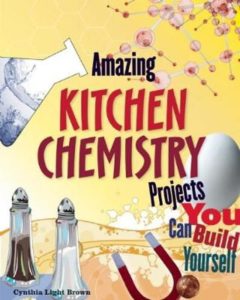 |
Cynthia Light Brown’s Amazing Kitchen Chemistry (Nomad Press, 2008) is a 10-chapter overview of chemistry, with background information, Words to Know lists, catchy fact boxes, and a lot of appealing hands-on projects and experiments. For example, kids made a buckyball, an alka-seltzer rocket, crystals, invisible ink, and oobleck. For ages 9-12. |
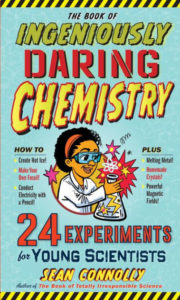 |
By Sean Connolly, The Book of Ingeniously Daring Chemistry (Workman, 2018) is an illustrated trip through the Periodic Table (Chapter 1: Hydrogen) with 24 hands-on experiments. For ages 9-14. |
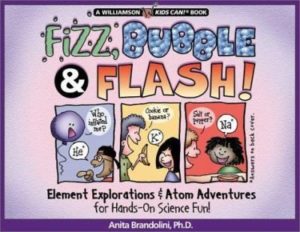 |
Anita Brandolini’s Fizz, Bubble & Flash! (Williamson, 2003) is a solid and cleverly presented introduction to chemistry, beginning with a comprehensive explanation of atoms, elements, and the Periodic Table. The book includes plenty of hands-on activities and presents fascinating facts and supplementary information in boxes and sidebars. Illustrated with humorous cartoons and photographs. For ages 9-13. |
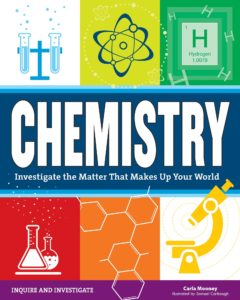 |
Carla Mooney’s Chemistry (Nomad, 2016) is an overview of chemistry with cartoons, sidebars, exercises, key questions, and hands-on investigative projects. For ages 12-15. |
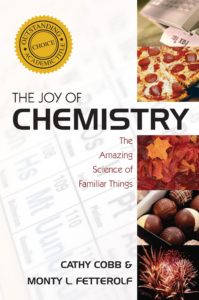 |
By Cathy Cobb and Monty L. Fetterolf, The Joy of Chemistry (Prometheus Books, 2010) is a hands-on introduction to chemistry. (The book begins with a “Shopping List” of all the supplies you’ll need to buy or make to complete the experiments.) First experiments (a bang and a splat) are a bottle rocket and a batch of oobleck, just to get the book off to an exciting start – but this is more than just a bunch of catchy demos; it’s a serious introduction to chemistry in 390 pages, well-written, and using lots of quotations and readily understandable references to things encountered in everyday life. Like pizza cheese. For ages 14 and up. |
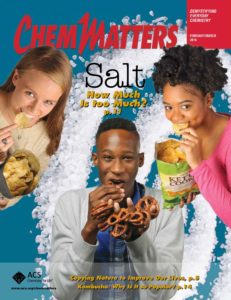 |
From the American Chemical Society (ACS), ChemMatters magazine is wonderful educational magazine filled with fascinating articles about chemistry in everyday life, plus hands-on activities, puzzles, and detailed teacher’s guides. Back issues (for the last three years) are available in print; and the ChemMatters CD has all issues and teachers’ guides from 1983-2008 ($30). A print subscription to ChemMatters costs $16 annually. Highly recommended. For ages 12 and up. |
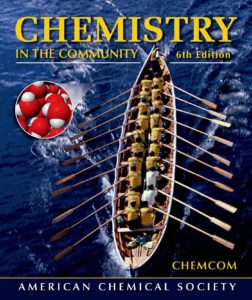 |
The ACS also sponsors a pair of innovative chemistry textbooks for high-school- and early-college-level students, both interestingly centered around the chemistry of various important social, political, economic, and ethical issues. These books do not, some textbook reviewers caution, substitute for conventional chemistry texts – for example, they don’t cover the history of chemistry – but they’re extremely well written, heavily hands-on-based, and dedicated to demonstrating how essential a knowledge of chemistry is to major problems in the real world. The high-school text, Chemistry in the Community (W. H. Freeman, 2006) consists of seven detailed study units, variously covering water, materials, petroleum, air, industry, nuclear energy, and food, each with chemical concepts, laboratory exercises, data analysis explanations of crucial problems, and supplementary challenges. |
| The unit on water, for example, begins with a pair of newspaper articles detailing a fish kill and accompanying water emergency in the imaginary community of Riverwood. Kids then investigate water properties, water purification techniques, household and national water usage, and Earth’s hydrologic cycle. Here’s one supplementary sample challenge: You’re marooned on an island in the ocean. The only available water on the island is a murky stagnant pond. Your survival kit contains a nylon jacket, a plastic cup, two plastic bags, rubber tubing, a knife, a bottle of liquid bleach, an empty glass bottle, and a bag of salted peanuts. How are you going to produce drinkable water? | |
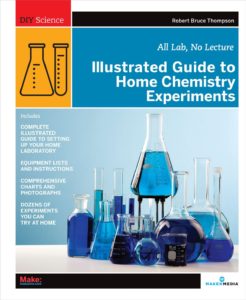 |
Robert Bruce Thompson’s 400+-page Illustrated Guide to Home Chemistry Experiments (All Lab, No Lecture) (Make Books, 2008) is a serious, detailed, and well designed and organized volume, intended for do-it-yourself chemists, homeschoolers, and conventionally schooled kids looking for a hands-on supplement to at-school mostly-lecture chemistry courses. (Available in pdf format here.)
The first few (very thorough) chapters are devoted to the basics of supplying and using a home chemistry lab, with detailed lists of necessary glassware, equipment, and chemicals, safety precautions, and instruction in such essential laboratory skills as maintaining a lab notebook, making accurate measurements, handling chemicals properly, using a balance and an alcohol lamp, bending glass tubing, and titration and filtration. |
| The remaining 17 chapters – which comprise about two years’ worth of high-school-level chemistry labs – each include multiple lab exercises centered around a specific chemical topic, variously appropriate for a range of expertise, from beginner to advanced. Topics were selected to ensure that kids get a thorough grounding in chemistry, and run the gamut from Separating Mixtures, Solubility and Solutions, and Acid-Base Chemistry to Chemical Equilibrium, Gas Chemistry, Colloids and Suspensions, Quantitative and Qualitative Analysis, Synthesis of Useful Compounds (kids make rayon and oil of wintergreen), and Forensic Chemistry. | |
| Each lab has well-presented background information and explanations, a list of equipment and supplies, very detailed step by step instructions illustrated with color photographs, charts and tables to be filled in with student data, and review questions. Helpful boxes provide additional information and definitions, suggested modifications and extension activities, comments and hints from scientists, and disposal instructions. | |
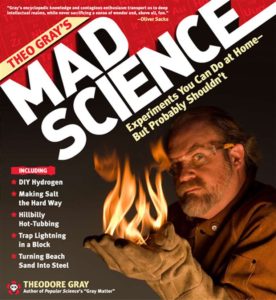 |
Theodore Gray’s MAD SCIENCE: Experiments You Can Do at Home – But Probably Shouldn’t (Black Dog & Leventhal Publishers, Inc., 2009) inevitably brings to mind Jean Shepherd’s A Christmas Story, in which nine-year-old Ralphie wants a Red Ryder B-B gun for Christmas, but is balked by all adults, on grounds of “You’ll shoot your eye out!” MAD SCIENCE is the Red Ryder B-B gun of chemistry, the stuff all proto-scientists crave as kids. Some of it is – yes – dangerous. It’s also a wonderful read. The book is 200+ pages long, every one of them illustrated with gorgeous and dramatic color photographs, and crammed with fascinating information and step-by-step instructions for carrying out truly spectacular experiments. Who wouldn’t want to make titanium in a flowerpot? Lightning in a can? Use your barbecue grill to turn sand into glass? This is great stuff. Just use commonsense. |
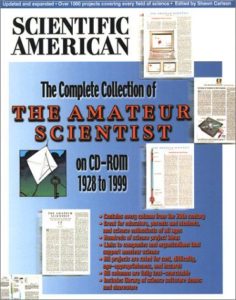 |
Scientific American magazine’s “Amateur Scientist” column was for decades a prime source for bright hands-on science hobbyists of high-school age and up. Though the column has since been discontinued, its entire content is now available on CD-ROM for Windows, Mac OS, Linux, and UNIX. This contains over 1000 challenging projects from all fields of science, categorized by discipline, cost, difficulty, and danger (on a scale of 1 to 4, 1 being “no hazard” and 4 being “possibly lethal”). Chemistry projects include “How To Blow Soap Bubbles That Last for Months or Even Years,” “Making a Refractometer for the Identification of Liquids,” “How to Build a Gas Chromatograph,” “Chemical Systems That Oscillate Between One Color and Another” (also known as a “chemical clock” and very cool), and many more. Mind-expanding for the scientifically curious (and great for science fairs). About $30. |
